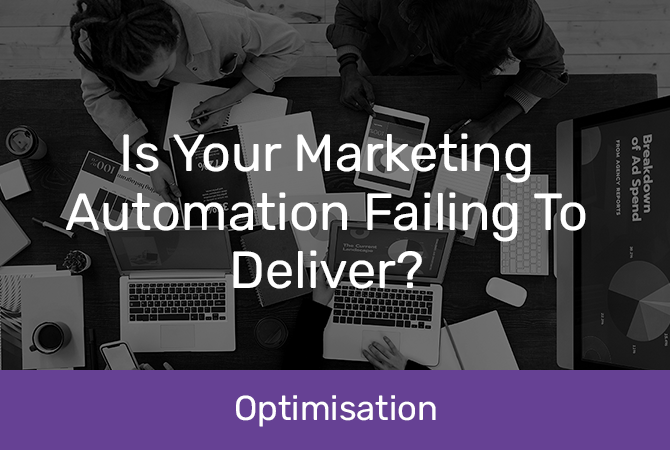
Is Your Marketing Automation Failing To Deliver?
Marketing Automation Troubleshooting
What happens if you invest in a marketing automation tool, but the promised benefits don't materialise? Are you struggling to find valuable insights, and have staff spend too much time trying to use the tech?
It happens – and it can lead to some serious finger-pointing. The CEO thinks it's the strategy, the IT team blames marketing, marketing blames the platform, and the way forward is not left any clearer.
The good news? Finding out what's behind these challenges is possible – you just have to ask the right questions.
 Teasing out the reasons for your marketing automation woes
Teasing out the reasons for your marketing automation woes
In many cases, there's no single reason for disappointing results. When marketing automation isn't delivering the goods, there are often a few reasons why.
Unclear strategy
A good strategy should lay out the goals of your programme, key automated touchpoints in your consumer experience, and the people responsible for managing each part of the customer journey.
If your strategy isn't on-point, you could be focusing on the wrong metrics – for example, looking for sales results while your automation efforts aim at the lead generation end of the funnel or you are not able to identify the link in customer journeys from message engagement through to conversion.
Over-automation
Believe it or not, there is such a thing as too much automation. Handing every part of your sales process to a piece of software could mean missing opportunities for human input. For example, always receiving automated responses to inquiries can feel unhuman, especially if you were after a more detailed response to your initial query.
No personal touches
Personalisation is more than just a nice to have – 80% of consumers prefer to shop with a brand that provides personalised experiences. If you’re communicating like a machine without including human touches like names, recent interactions, or a related piece of customer information, you could be serving up a generic, impersonal consumer experience that simply turns customers off.
Failure to test
Test, test, and test again – that's the digital marketing mantra for a reason. If you're automating but not testing, you could be wasting money on content that just doesn't work – ads that don't pull in clicks, emails that don't get opened, and lead generation strategies that fall flat. Start testing and adjusting strategies in real time, and your results could turn around.
Low-Quality data
What drives all that lovely automation and personalisation? Data, of course. If you're using inaccessible, incomplete, or out-of-date data, your automation platform won't perform at its peak. A specialist data management tool like a customer data platform (CDP) can be invaluable here.
 How data drives marketing automation
How data drives marketing automation
Marketing automation tools manage the outputs for your business in the form of messages, campaign content, and audiences. But they rely on data to direct and optimise those outputs. Data, whether that’s pulled from your CRM, website, PoS, social media or sales, gives your automation platform a comprehensive view of your consumer and your campaigns. This lets you target specific audiences, personalise content, and create campaigns more likely to resonate with your consumers.
All this means that the quality of the data matters. If you have limited datasets feeding into your platform, if data is out-of-date, or if it's difficult to access, your automation platform won't perform as well as it should – and you could end up with lacklustre results.
For example, if you only access current consumer, PoS and email data, but not website data, it will miss some key touchpoints on your consumer journey. A consumer visits your store, browses your site, and signs up to your email database, but only the first two elements are managed through your automation platform, meaning you have a conversion, but you can’t see the journey that led the consumer to that point. Essentially, leaving you with an incomplete picture of your marketing automation performance.
Do better with a customer data platform
Want to feed your automation platform with high-quality data? A customer data platform (CDP) is your best bet. CDPs aggregate and analyse information from various touchpoints and then feed it through to other systems – like automation platforms. Unlike a data warehouse or other large-scale data management tool, a CDP has a limited scope, usually focusing on data from one business area. This makes CDPs manageable and fast-moving – ideal for the quick-step world of automation.
Marketing automation uses operational customer data platforms most often. These specialist CDPs offer real-time reporting and analysis for a specific business area, supporting the work of your marketing automation platform with valuable insights and real-time data.
 Signs it's time to adopt a customer Data platform
Signs it's time to adopt a customer Data platform
How can you tell that your marketing automation needs support from a CDP? It’s about more than just a general lack of action from your platform. Instead, look at what your current data management system is missing, and the automation features it can’t deliver.
Here are some signs to watch for:
Overgrowing your old system
You have high volumes of consumer data and want to store, analyse, and feed it to your marketing automation platform. The problem? Your current storage system can't handle data at that volume, or process the data at the speed you need, making it difficult to access information or surface valuable insights to drive your results.
slow-moving analytics
To optimise future campaigns, you need to understand campaign performance as it is happening. However, if your existing data management system can't analyse at the speed or complexity you need, getting those insights and optimising as you go isn't simple.
Struggling to integrate sources
Integrating data from multiple sources helps you automate and take action on every part of the consumer journey – but without seamless integration, it can't be done. Can your current system pull in data from your social media activity, PoS, website, and CRM and in turn pull out vital insights?
Inadequate performance tracking
To optimise future work and share with stakeholders you need to be able to track and report on every element of your marketing campaigns. If your current system can't track or report at the right level of granularity, it’s not up to scratch.
no roi insights
ROI is another crucial part of campaign performance tracking – some might say the most important. Your data management system should be able to measure ROI without significant manual input.
 Integration: How does a CDP work with your marketing automation platform?
Integration: How does a CDP work with your marketing automation platform?
How, exactly, does a customer data platform help your marketing automation platform deliver deeper insights and personalise at scale? It all comes down to integration. A CDP is an automation layer sitting between your automation platform – Acoustic, Braze, or Adobe, for example – and your data sources. Essentially, the CDP acts as a translator and editor, pulling key data points from what’s available, then sorting, analysing, and putting them into a position your platform can use.
The true value comes next: it can create analytical variables based on consumer behaviour and other data points and use these insights to create personalised experiences and drive engagement.
 Troubleshooting your marketing automation platform
Troubleshooting your marketing automation platform
If your marketing automation efforts aren't paying off, there could be any number of reasons – from a vague strategy to lack of personalisation, through inefficient processes and processing, or even over-automation. One common cause: poor-quality data. If the data you're feeding into your platform is incomplete and outdated, your results will be, too.
A CDP collects information about your consumers at every stage of their customer journey – from browsing data to engagement metrics to sales information – and your marketing automation platform uses that data to personalise on a large scale with precision. Imagine how effectively you could target a single consumer if you could track all their interactions and understand their preferences, then expand that to your whole consumer network. That's the power of the CDP/marketing automation partnership.
Could a customer data platform solve your automation issues? Talk to the team at Datamine to find out. At Datamine, we work with clients across Australia and New Zealand in almost every sector – from retail and banking to not-for-profits.















































